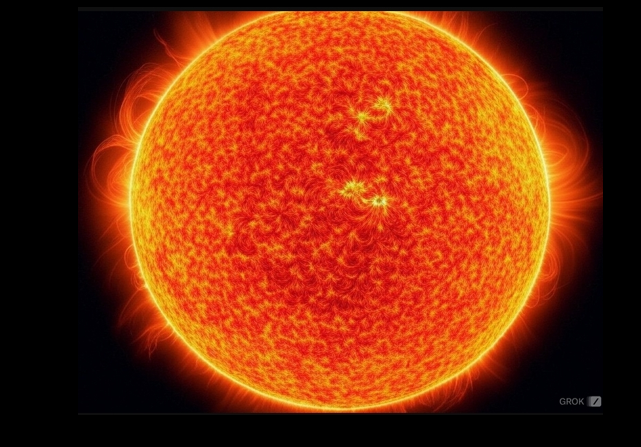NASA’s Parker Solar Probe to Make Closest Approach to the Sun on Christmas Eve
“We will be embracing a star.”

The National Aeronautics and Space Administration (NASA) groundbreaking spacecraft, the Parker Solar Probe, was launched in 2018 to study the Sun’s outer corona.
It is the fastest object ever built on Earth, capable of reaching speeds up to 430,000 mph at its closest approach to the Sun…which is required to avoid being pulled in due to enormous gravitational forces.
The spacecraft is performing better than expected and will now make its closest approach to the Sun on Christmas Eve.
Parker Solar Probe will pass 6.1 million kilometers from the sun at 6:53 a.m. Eastern Dec. 24, the closest approach to the sun by this or any other spacecraft. At the time of closest approach, the spacecraft will be traveling 191 kilometers per second.
The spacecraft launched in 2018 and used a series of gravity-assist flybys of Venus to lower its perihelion. The final Venus flyby, on Nov. 6, set up the spacecraft for this perihelion, the closest the spacecraft will fly to the sun on its mission.
“On Christmas Eve of this year, Parker Solar Probe will be the closest humanmade object ever to a star,” said Nour Rawafi, project scientist for the mission at the Johns Hopkins University Applied Physics Lab (APL), during a media roundtable at the annual meeting of the American Geophysical Union Dec. 10. “We will be embracing a star.”
It won’t be known how the probe did for a few days after this approach, as it will be out of communication range.
Parker planned to get more than seven times closer to the sun than previous spacecraft, hitting 430,000 mph (690,000 kph) at closest approach. It’s the fastest spacecraft ever built and is outfitted with a heat shield that can withstand scorching temperatures up to 2,500 degrees Fahrenheit (1,371 degrees Celsius).
It’ll continue circling the sun at this distance until at least September. Scientists hope to better understand why the corona is hundreds of times hotter than the sun’s surface and what drives the solar wind, the supersonic stream of charged particles constantly blasting away from the sun.
Legal Insurrection readers may recall I reported on a coronal “hole” in the Sun, as big as 20 Earths, back in 2023. I have also noted the recent uptick in solar storms as well.
The Parker Probe, named after Eugene Newman Parker (the physicist who first theorized the existence of solar wind), is designed to obtain data that will help scientists understand this phenomenon.
…[T}he first images from the close encounter will likely be beamed back to Earth sometime in January, the agency said.
As the Parker Solar Probe swoops close to the sun, it will likely fly through plumes of solar plasma and could even dive into active regions of the star, [Kelly Korreck, a program scientist in NASA’s heliophysics division] said.
The mission was designed to study the outermost part of the sun’s atmosphere, an ultrahot region known as the corona. Scientists are keen to observe the corona up close because researchers have long puzzled over why the outer layer of the sun’s atmosphere is hundreds of times hotter than the star’s surface.
Observing the corona will also help researchers study how storms that brew on the sun’s surface erupt into space. The probe will, for instance, be able to observe streams of the highest-energy solar particles as they are hurled from the sun, exploding into the cosmos at supersonic speeds.
If the probe completes a successful flyby, the data obtained will hopefully lead to a better understanding of solar behavior and an enhanced appreciation of its influence on Earth.
However, I will conclude with a little humor that fellow Star Trek fans may appreciate.
Actual photos of Parker Solar Probe on Christmas Eve 2024. pic.twitter.com/P67WP606Xv
— lawrence (@lcagee) December 23, 2024
 DONATE
DONATE
Donations tax deductible
to the full extent allowed by law.









Comments
I can’t fathom that we have produced an object that can withstand the rigors that it will face. Absolutely amazing.
Bonus points for the Star Trek reference!!
“on Christmas Eve”
That’s thinkin’ smart — to go at night.
Cool post. 430,000 mph, wow!
To me, it is metaphorical, not merely coincidental, that the photo of the sun is similar to that of fertilized human egg.
I read recently that at the moment of fertilization the egg emits a flash of light (something to do with zinc, I think).
How great is our God.
There are pictures of it
Hard not to believe it isn’t the moment of our soul entering the egg and life has begun
And here is that “flash”
When sperm
Enters the egg and life begins
Yes LIFE
https://www.sciencealert.com/scientists-just-captured-the-actual-flash-of-light-that-sparks-when-sperm-meets-an-egg
No, there is no flash of light, no sparks. The reports were of a simulation that used a fluorescent tag to track the zinc level.
Appropriate for Christmas eve:
“Unto you that fear my name shall the Sun of righteousness arise with healing in his wings”
A prophetic reference for the coming of Christ, so:
Merry Christmas
Happy Hannukah
Joy to the world
And Happy Kwanzaa
Although I’ve never met a black person who celebrates it, I understand it is quite popular with white, liberal school teachers.
You see pictures of black people dressed in African clothing, usually out east or California
Kamala’s sorta black.
Kamala Harris’s parents used to celebrate it, since they were both acolytes of the whack job who invented it. So she grew up with it and thus to her it’s completely normal, as is any custom we grow up with and assume everyone else does too, however peculiar it may actually be.
Bot, it’s a good thing the satellite is going around the sun at night or it would be too hot for it
Lol
Go at night. It’s cooler then.